In recent years, skincare has become more personalized and science-based, with a focus on ingredients that support skin health without unnecessary complexity. One such ingredient gaining attention is hypochlorous acid (HOCl). Known for its gentle yet effective properties, hypochlorous acid face spray is becoming a reliable step in daily skincare routines. This article explores how you can boost your skincare routine with hypochlorous acid face spray, its benefits, and how to use it properly.
What Is Hypochlorous Acid?
Hypochlorous acid is a naturally occurring molecule produced by white blood cells as part of the body’s immune response. It helps defend the skin from harmful bacteria, viruses, and inflammation. In topical form, HOCl is replicated through an electrochemical process to create a gentle solution that mimics the body’s natural defenses.

This form of hypochlorous acid is non-toxic, non-irritating, and safe for regular use on the face. It has been widely used in medical settings for wound care and disinfection, which speaks to its safety and efficacy when applied to sensitive or compromised skin.
Key Benefits of Hypochlorous Acid in Skincare
Using hypochlorous acid face spray provides several practical advantages, especially for those with sensitive or acne-prone skin. Below are some of the primary benefits:
Antibacterial and Antimicrobial Support
HOCl helps neutralize harmful bacteria on the skin’s surface without disrupting the natural microbiome. This makes it suitable for those dealing with breakouts, blemishes, or skin that is prone to inflammation.
Calms Redness and Irritation
Because hypochlorous acid is naturally anti-inflammatory, it can reduce visible signs of irritation and redness. It’s often used to calm post-procedure skin or soothe flare-ups from conditions like eczema or rosacea.
Accelerates Skin Recovery
Regular use may support faster healing of minor cuts, acne lesions, or other skin disruptions. Its compatibility with sensitive skin means it can be used multiple times a day without increasing dryness or discomfort.
Supports Skin Barrier Function
Maintaining a healthy skin barrier is key to hydration and resilience. HOCl does not strip the skin and can be layered with other products like moisturizers or serums to improve overall routine effectiveness.
How to Use Hypochlorous Acid Face Spray in Your Routine
Introducing a hypochlorous acid face spray into your skincare regimen is simple. It works well as a prep step or throughout the day as needed. Here’s how you can include it:
After Cleansing
Spray HOCl directly onto clean, dry skin. Allow it to air dry before following up with toner, serum, or moisturizer. This prepares the skin and ensures it’s free of lingering bacteria that can lead to breakouts.
Before or After Makeup Application
The gentle nature of HOCl makes it useful before applying makeup to create a clean base. It can also be used after makeup removal to calm the skin and reduce irritation caused by cosmetic products.
Post-Workout or Outdoor Activity
If you sweat often or spend time outside, carry a small bottle of hypochlorous acid spray. A few spritzes can help prevent buildup and refresh your skin without needing to wash your face repeatedly.
After Skin Treatments
Following procedures like chemical peels, microneedling, or laser treatments, your skin may be red and sensitive. HOCl can be safely used during recovery to calm and protect the area.
Who Can Benefit from Hypochlorous Acid Face Spray?
Almost anyone can incorporate hypochlorous acid into their skincare routine, but some skin types and conditions benefit more noticeably:
Acne-Prone Skin
By reducing bacteria without over-drying, HOCl helps prevent future breakouts while supporting the healing of current ones.
Sensitive Skin
Because it mimics the body’s own natural defense molecules, HOCl is less likely to cause irritation, making it suitable for those who react poorly to harsher ingredients.
Post-Procedure Skin
Patients recovering from cosmetic or dermatological treatments can safely use hypochlorous acid to reduce inflammation and the risk of infection.
Aging Skin
While HOCl doesn’t target wrinkles directly, its ability to maintain skin clarity and barrier health supports the overall appearance of aging skin when used in conjunction with anti-aging treatments.
Storage and Shelf Life
To ensure hypochlorous acid maintains its effectiveness, it should be stored in a cool, dark place, ideally away from direct sunlight. Some formulations come in opaque or UV-protective bottles for this reason. Check the expiration date and use the spray within its recommended period, usually 2–3 months after opening.
Potential Drawbacks or Considerations
While hypochlorous acid face spray is generally safe, there are a few things to keep in mind:
-
Not a replacement for all treatments: HOCl works best as a supporting step, not a standalone solution for severe acne or chronic skin conditions.
-
Stability issues: HOCl can degrade over time or if exposed to light and heat. Make sure to purchase from reputable brands with proper packaging.
-
Mild smell: Some formulations may have a faint chlorine-like scent, which usually dissipates quickly after application.
Final Thoughts
Adding hypochlorous acid face spray to your regimen is a practical, low-risk way to boost your skincare routine with hypochlorous acid face spray. Its gentle, multi-purpose properties make it suitable for various skin types and concerns, particularly for those seeking balance and support without irritation.
Whether you're managing breakouts, recovering from procedures, or simply maintaining daily skin health, this spray can serve as an effective and reliable addition. When used correctly, it complements both minimal and multi-step routines.























